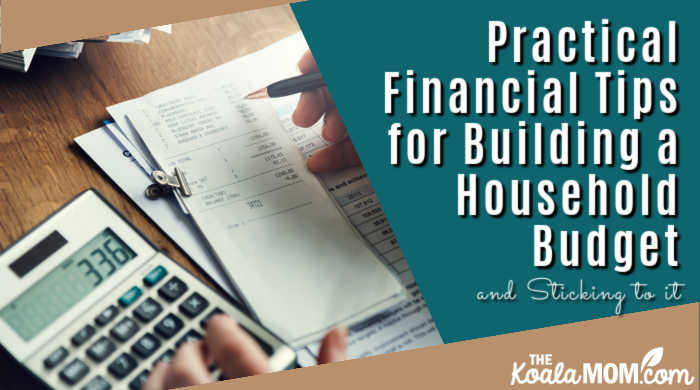Money sometimes causes stress in a relationship, and it can be complicated to manage when you are trying to build a household budget. Unexpected expenses seem to just keep on coming. However, with a little planning and discipline, you can create a budget that works for your family and stick to it. This blog post discusses practical financial tips for building a household budget.

Merge your debts
People who have several credit cards or loans with high-interest rates benefit from consolidating their debts into one lower-interest loan. This simplifies your monthly payments and can save you a significant amount of money in the long run. Explore the internet, where you may find secured business loans that can provide a good insight into your loan options.
More often than not, the monthly payments will be lowered, and you’ll have an easier time keeping track of your debt. Other loan options include balance transfer credit cards or personal loans.
Automate your bills
Set up automatic payments for recurring expenses such as insurance, utilities, rent / mortgage, and car payments, to name a few. This saves time and helps ensure that these important bills are paid on time every month.
It can also help prevent those pesky late fees that can add up quickly. Late fees can rapidly derail your budget, so automating these payments can help keep you on track.
In this case, you can use software that can manage all your bills and expenses in one place. You can also take advantage of apps that offer cashback and rewards for paying your bills on time. When you have everything automated, it’s easier to stay on top of your expenses and stick to your budget.
Set a spending limit
One of the easiest ways to stick to your budget is by setting a spending limit for each category, such as groceries, entertainment, and clothing. Determine what you can realistically afford to spend in each area, and then make it a point not to go over that amount.
For instance, if you have $200 per week for groceries, stick to that limit by planning your meals and using coupons or sales. I find that ordering groceries online (either for pickup or delivery) helps me to stick to my weekly grocery budget, as I can see the total adding up as I shop and then add or delete items from my cart to ensure that I’m within budget before placing the order.
Consider finding free or low-cost recreational activities such as hikes, picnics, and visiting local parks for entertainment.
Finally, for clothing, set a limit for yourself and consider shopping at thrift stores or waiting for sales to make your money stretch further. Setting these spending limits helps keep unnecessary purchases in check and keeps you on track with your budget.
Set aside a little each month for unexpected expenses
Unexpected expenses are bound to pop up from time to time, whether car repairs or medical bills. Set aside a small monthly amount in a separate savings account to have funds available when these situations arise. This will help prevent the need to put the expense on a credit card and rack up more debt.
If you need to dip into this emergency fund, make sure to replenish it as soon as possible so that you always have a backup source of funds in emergencies. You may need to cut back on some expenses or find additional ways to bring in income, but it will be worth it in the long run.
Save up for annual expenses too
While planning a monthly budget, you also need to consider expenses that happen annually. For example, your city utility bill or life insurance payments may only occur once a year. You can try to switch these to monthly payments but often you’ll save money by paying annually. (See where else you could save money in your budget by paying annually rather than monthly!)
In the case of annual bills, simply divide the amount of the bill by 12 to get the monthly amount. Then add that amount to your monthly budget, and ensure that each month, you are putting that amount into a savings fund set up for annual bills. When the annual bill arrives, use the money from that savings fund to pay the bill. (Jessie Fearon has a great post about using a “funds” budget system.)
Evaluate expenses regularly
Take time each month to review your spending and look for areas where you can cut back or eliminate unnecessary expenses. Maybe there is a gym membership you never use or expensive cable channels you could live without. In this case, consider canceling or downgrading these expenses to save money.
It’s also important to regularly review your bills and shop for better deals on car insurance, cell phone plans, and utilities. You may be able to save a significant amount of money by switching providers or negotiating for lower rates. Regularly evaluating expenses can help keep your budget on track and prevent overspending.
Communicate with your partner
It’s essential to openly communicate with your partner about finances and stick to the agreed-upon budget as a team. Set aside time each month to discuss any financial concerns or adjustments needed, and work together towards meeting your goals. For example, if one of you has a significant expense, such as a vacation or a new car, make sure to set aside the necessary funds and cut back on other costs to afford it. Working together towards shared financial goals can benefit your budget and strengthen your relationship.

By following these practical tips, you can create a household budget that works for your family and successfully stick to it. Don’t let money be a source of stress in your relationship – take control and plan for financial success. Rest assured that you can achieve your financial goals as a team with discipline and planning.
Photo credit: Depositphotos.

No Responses Yet